Oil Recovery Using Solar Energy


A Fremont, California-based solar company says it has developed sun-powered technology for use in a surprising location: oil fields.
GlassPoint Solar was founded in February 2009 and began work on its first solar-enhanced oil recovery (EOR) project in 2011.
Today, GlassPoint has offices in Oman and Kuwait, in addition to its California home. The company completed several projects and is working on what will be one of the world’s most expansive solar plants. Called Miraah, the project will produce more than a gigawatt of energy for use in an oil field in Oman.
Enhanced oil recovery (EOR)
The oil industry has been using methods of enhanced oil recovery (EOR) for years. EOR involves injecting a substance into an oil reservoir that makes it easier to extract the oil and leads to a higher yield. Usually steam, natural gas, carbon dioxide or nitrogen is pumped in to either lower the viscosity of the oil or force it out of the reservoir. Chemical injection is also used, but to a lesser extent.
The method that GlassPoint Solar works with is steam. Typically, energy companies use natural gas to produce the steam, which they pump into the ground. GlassPoint Solar’s technology, however, uses energy from the sun.
About the technology
GlassPoint Solar employs mirrors suspended within a greenhouse, which concentrate and direct sunlight to pipes that contain water for use in the oil field. The concentrated sunlight heats this water to produce steam, which is then pumped into the oil reservoir.
GlassPoint's system uses many of the same pumps, pipes and controls as natural gas-powered EOR, meaning it can be easily integrated with existing equipment.
The company says its solar technology can produce 80 percent of the steam needed for an oil field’s EOR in a given year. (The remaining steam can be produced using natural gas when there isn’t enough solar energy available.)
GlassPoint also says its solution is cost-competitive with using natural gas. The fact that the technology is enclosed in a greenhouse helps to shield it from the elements. This means smaller upkeep costs compared to traditional solar. The company also doesn’t need to use as much steel and concrete to stabilize the equipment, and can use cheaper materials to produce it.
The technology can also save oil companies money, GlassPoint says, because they won't have to burn their natural gas in order to extract oil.
Effect on the environment
Of course, burning oil has a negative effect on the environment. Many conservationists say we need to kick our fossil fuel habit entirely. But until we do, solar technology could help to reduce the environmental impact of the oil industry.
Fossil fuels don’t just create emissions when consumers or businesses use them. Producing them requires a lot of energy and creates a lot of pollution, as well.
Oman uses 23 percent of its natural gas for EOR. Kuwait burns more gas for oil production than for electricity. Replacing that natural gas with solar will reduce the emissions associated with producing oil.
While using a renewable energy source like solar would obviously be greener than either, natural gas beats out oil in the environmental friendliness department. Using less natural gas for oil production means natural gas could replace some of the oil used to produce power.
Future
There’s some uncertainty about whether this technology is green and whether it’s better for the solar industry or for the oil industry.
It’s good to see solar replacing some natural gas use, and GlassPoint Solar’s projects create some positive visibility for solar. But some say the company's solutions help to pull oil out of the ground, which is not sustainable in the long term.
That oil would likely be pulled out of the ground anyway. But it's possible this new tech may eventually make it cheaper for companies to extract oil, causing them to remove oil that otherwise would have been left in the earth. Or, it could help pull off a difficult balancing act, reducing the oil industry’s toll on the environment, which still provides raw material for countless other industries.
However, if the project is successful, it may nudge companies in other industries to adopt the use of solar. This could propel forward the development and widespread use of solar technology, as well as reduce emissions from energy use. Perhaps it could also lead to government incentives for reducing carbon emissions during oil production.
The oil industry is interesting new territory for solar power. Although this new technology helps to produce oil, it decreases the emissions involved in production, which is a step in the right direction. The long-term effects of GlassPoint Solar’s technology remain to be seen.
Image via: GlassPoint Solar
Gun Fans Flee Levi's But Can't Run From CSR
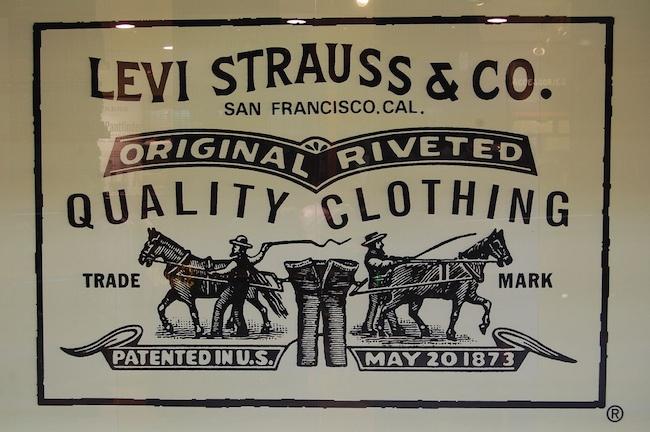

Levi Strauss & Co. CEO Chip Bergh issued an open letter last week asking people to refrain from bringing firearms into the company's stores, offices and other facilities. The politely worded request -- and it was a request, not a directive -- was met with a firestorm of criticism from gun advocates. Some said they will ditch their Levi's jeans in favor of Wrangler, a threat that was in some instances accompanied by anti-Semitic and pro-Trump messaging.
However, a quick look at Wrangler and its corporate parent demonstrate that the CSR movement leaves the anti-Levi's movement with little room to grow.
Levi-Strauss has been there before
Levi-Strauss is no stranger to criticism over gun rights and other social issues. The company has been under the gun lobby's microscope since at least 2000, when it paired up with the band Goo-Goo Dolls in a campaign against gun violence.
In 2011, the formerly influential pundit Glenn Beck declared he would boycott Levi's over a television ad campaign he said featured "young people reveling in rioting."
The ad sparked a "Boycott Levis" Facebook page that issued four posts between September and October 2011 before it lapsed into dormancy.
The Bergh letter appears to have breathed new life into the account -- and a new post appeared last week:
In 2013, National Public Radio noted that Levi-Strauss appeared on the National Rifle Association's list of "National Organizations with Anti-Gun Policies."
The idea that Wrangler is a more politically attractive brand for gun fans is also not new. In 2014, the site Young Conservatives included Levi-Strauss in its list of "20 Massive Companies That Want To Take Your Guns Away," advising its audience to "buy Wranglers instead."
In 2013, the gun fan forum ar15.com featured a number of comments stacking Levi's up against Wranglers. Some participants in the forum eschewed gun politics in favor of politically-neutral benchmarks, as demonstrated by this Texas poster's pithy observation (edited to be SFW):
"levi's cut into my n***s and are tight in the thigh in my waist size, so I wear wranglers."
Another commenter from Nevada took a more straightforward dig at Levi's over gun rights:
"F**k Levi's and their anti-gun bulls***t."
A participant from Michigan took a broader perspective on corporate behavior and came up empty, such as this one:
"Levis went to s**t in the 90's.
Then they went full chum guzzler with the anti 2A bulls**t, and made in Chinese sweat shops.Wranglers fit better, but they went to s**t when they switched production to Mexico ..."
Switching brands in a CSR world
Accurate or not, that last comment makes an important point about corporate behavior and boycotts.
When you boycott a company, it's probably a good idea to research the alternatives and make sure you don't end up giving your dollars to another company with similar policies.
In the case of Wrangler, gun fans do seem to be on pretty safe territory. But through its parent company, VF Corp., Wrangler embraces a diversity and inclusion policy that is at odds with some of the reaction to the Bergh letter.
For example, here is a tweet reported by Raw Story:
((( @LEVIS ))) doesn't want customers bringing guns into their stores. Another reason to avoid these Jew jeans at all costs.
And, here is the official VF position on diversity:
"At VF, the diversity of our workforce makes a world of difference. Our respect for each other’s unique experiences, perspectives and skill sets is woven throughout the fabric of our culture and guides our actions."We encourage our 60,000-plus associates to bring their authentic selves to work every day, and our results show it; when we each feel valued for who we are and what we offer, we give our very best."
The Wrangler website provides a handy disclosure of its relationship with VF:
"As part of VF Corporation, Wrangler believes that integrity never goes out of style. In fact, we see it as a direct result of the values we embrace - as a company and as people. Values like honesty, consideration and respect. For us, these are more than words. They are embedded in our work and form an integral part of our daily operations."
Wrangler also provides a diversity boilerplate when advertising job openings online:
"... All qualified applicants will receive consideration for employment without regard to race, color, religion, sex (including pregnancy), sexual orientation, gender, gender identity and/or expression, age, national origin, uniform services, protected veteran status, disability, medical condition, genetic information, citizenship status (when otherwise legally authorized to work), pregnancy, marital status, or ancestry ... "
So ... now what?
Levi's boycotters who are looking for an alternative may identify with Wrangler. But the other labels that make up VF Corp may give these boycotters pause, including well-known brands that have crossed over from outdoor culture to urban lifestyle such as the North Face, Timberland and Vans.
Some boycotters may also be surprised to learn about VF's positions on climate change. The apparel holding company has a solid track record on sustainability, and it joined other major U.S. companies in the Ceres-sponsored BICEP climate change declaration back in 2013.
Among other recent activities, VF also participated in the 2015 Sustainable Brands conference, and this is where things get interesting.
At the conference, VF sent out a strong signal that its brands would pull their sustainability strategies together into a “unified parent-corporation center of goal-setting, excellence and governance.”
Levi-Strauss has already set a high bar for corporate social responsibility (CSR) in the global apparel marketplace, especially in terms of environmental issues. And now it looks like VF is gearing up to cement a far-reaching CSR profile of its own.
If VF's unified sustainability initiative ripples out to include other features of a strong CSR program, look for VF and its brands to build a more assertive public profile on social issues.
We're not saying that VF has any intention of engaging consumers on the issue of gun violence any time soon, but don't be surprised if it does.
For the record, Chip Bergh served in the U.S. Army at the rank of Captain. Before joining Levi-Strauss in 2011, he spent 28 years in leadership roles at another iconic U.S. company with a growing CSR profile, Procter & Gamble.
Photo: by Lee Agas Guang via flickr.com, creative commons license.
Kellogg Pops the 'Alt-Right' Bubble
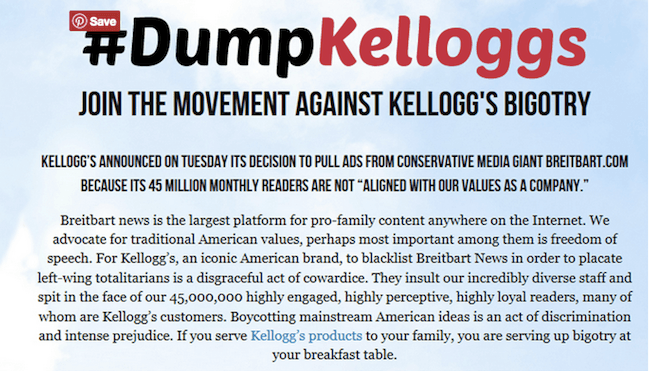

So ... that was fast. Last week, Kellogg Co. pulled its advertising from Breitbart, a website that has emerged as the voice of the so-called "alt-right" white supremacist movement in the U.S. Kellogg's decision immediately set off a loud, hot firestorm of protest from Breitbart, which called on its audience to boycott the company's iconic, all-American brands including Corn Flakes, Rice Crispies, and many (many, many) more.
In a classic case of backlash, the attention likely alerted other advertisers to Breitbart's role in providing a platform for racist, nativist, anti-Semitic and anti-Muslim hate groups. That could come back to haunt the site and its former chief executive, Steve Bannon.
Kellogg drops Breitbart
For those of you just catching up on the Kellogg's news, the basis of the issue is that a good portion of Internet advertising occurs through automatic platforms. Advertisers have to track where their ads appear and take steps to opt out if they wish to keep their ads from running on websites they deem offensive.
Kellogg has a solid corporate responsibility track record and pulled its ads from Breitbart with this comment from spokesperson Kris Charles (reported by Business Insider and others):
"We regularly work with our media buying partners to ensure our ads do not appear on sites that aren't aligned with our values as a company," Charles said. "This involves reviewing websites where ads could potentially be placed using filtering technology to assess site content. As you can imagine, there is a very large volume of websites, so occasionally something is inadvertently missed."
You can find a full list of Kellogg's company values on its website, which makes clear exactly why Breitbart does not make the cut.
Breitbart's own former chief executive, Steve Bannon, went on record last summer to promote the site as the voice of white supremacy. Sarah Posner of Mother Jones reported:
"We're the platform for the alt-right," Bannon told me proudly when I interviewed him at the Republican National Convention (RNC) in July. Though disavowed by every other major conservative news outlet, the alt-right has been Bannon's target audience ever since he took over Breitbart News from its late founder, Andrew Breitbart, four years ago.
Kellogg's diversity statement is especially interesting in the context of the Breitbart blowup:
A Message From Our President and CEO:We believe diversity and inclusion are essential to living our values, achieving our business goals and building a stronger Kellogg.
In an increasingly competitive global marketplace, we can only succeed when we attract and retain the best talent and when our employees reflect the diversity of our consumers.
And we are committed to creating an environment where all employees are included, are treated with dignity and respect and are in a position to contribute to our future success. Fostering all employees’ passion for our business will help us win in the marketplace.
Words matter, Part I
Breitbart could have just sucked it up and said goodbye to Kellogg's without fanfare. But someone up the food chain made the decision to punish the company by calling on readers to boycott Kellogg's products.
In the days since, the Intertubes were flooded with the kind of news that most A-list companies hope to avoid. And Kellogg's trickle could quickly turn into a flood as the awareness grows over Breitbart's role in the white supremacy movement.
One interesting development occurred last month, when Bloomberg noted that the Web advertising service AppNexus dropped Breitbart from its exchange over the use of "coded or overt" language inconsistent with the company's prescription against advertising on sites that promote violence.
The ripple effect could be significant, wrote Bloomberg staffer Mark Bergen. Though not nearly as well known, AppNexus is second only to Google in annual revenues for the automated advertising field.
That's no accident. AppNexus is backed by major-league companies including Microsoft, the global communications firm WPP and, somewhat ironically, News Corp., the parent company of Fox News.
AppNexus's focus on the language promoted by Breitbart turns up the heat on Google and Facebook, both of which are already facing blowback for their roles in circulating fake news.
It's also worth noting that AppNexus did not rely on an automated word filter to alert it to offensive content at Breitbart. The company used a "human audit" to catch dog whistles and other loaded language. Similarly, Kris Charles's statement indicates that Kellogg's deployed human input to fill a gap that automated filters left open.
Words matter, Part II
If Breitbart has been relying on coded language to slip under the radar of automatic filters and retain advertisers that might otherwise flee, its day of reckoning may be near.
A focus on Breitbart's use of coded language came into full bloom this past week, just as the Kellogg's boycott began to catch the media spotlight.
It's a day late and a dollar short, but news organizations have finally exposed the verbal sleight-of-hand Bannon deployed to make white supremacy palatable. His promotion of the term "alt-right" provides his audience with a simple way to deflect criticism, by making it appear as if their views represent just another degree of accepted conservative principles.
The Washington Post (owned by Trump nemesis and Amazon founder Jeff Bezos) was first to draw attention to Bannon's use of "alt-right" as a mask, in an article dated Nov. 21.
The Associated Press quickly added its weight. AP is the go-to source for professional journalism. In a blog posted dated Nov. 28, AP's vice president for standards had this to say:
"The 'alt-right' or 'alternative right' is a name currently embraced by some white supremacists and white nationalists to refer to themselves and their ideology, which emphasizes preserving and protecting the white race in the United States in addition to, or over, other traditional conservative positions such as limited government, low taxes and strict law-and-order."The movement has been described as a mix of racism, white nationalism and populism."
AP's instructions include using quotation marks and other qualifiers, for example, "the so-called 'alt-right.'"
AP also emphasizes:
"The term may exist primarily as a public-relations device to make its supporters’ actual beliefs less clear and more acceptable to a broader audience. In the past we have called such beliefs racist, neo-Nazi or white supremacist."
Where will the Kellogg's boycotters go?
If Breitbat's call for a boycott is effective, many readers will most likely turn to other top companies like General Mills or Post.
That's not going to be very effective if the aim is to punish companies that value diversity.
Here's a snippet from General Mills's CSR statement:
"We cultivate an inclusive environment by considering all dimensions of diversity – not just the primary areas of gender, race and sexual orientation – but also cultural aspects including values, preferences, beliefs and communication styles."
General Mills notes that its employees are active in affinity networks including: American Indian Council, Asian Heritage, Betty's Family LGBT, Black Champions, Hispanic, Middle East and North Africa, South Asian, Women in Leadership, and Veterans.
Under the umbrella of Post Holdings, the Post brand also promotes diversity and inclusiveness. The company also makes a bottom-line case for its position:
"We believe diversity brings strength and flexibility to our supply base and increases competition in the sourcing process. At Post, we value cultivating strategic procurement relationships with minority ‐ , women ‐ and veteran ‐ owned businesses that provide high quality and cost effective products. Above all, we want to support the businesses of the people who buy our products."
If either General Mills or Post advertise on Breitbart, they probably won't for long.
Meanwhile, reports of other companies pulling their ads from Breibart are beginning to pile up. Business Insider lists Warby Parker, Allstate, Nest and the financial firm SoFi.
As for Bannon, he left Breitbart earlier this year to become one of the chief architects of President-elect Donald Trump's campaign. He was tapped for the role of chief strategist for Trump as president.
If he was depending on Breitbart to continue amplifying the Trump message for the next four years with a healthy assist from its advertising income, he may be disappointed.
Image (screenshot): via Wonkette.
Some Rust Belt Workers Remain Skeptical of Job Retraining Programs
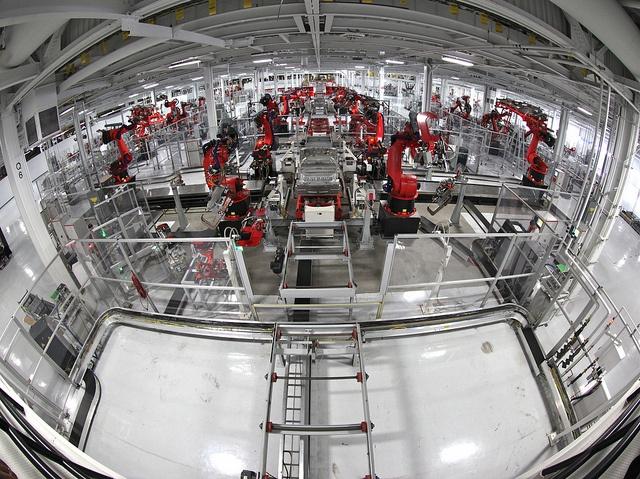

Hillary Clinton couldn’t win. The candidate often mocked for trying to be all things to all people actually had a plan she said could revive the U.S. manufacturing sector and retrain workers who lost their jobs. Her proposal was arguably tepid, but it was a plan. Voters in much of the Rust Belt didn’t want to hear it. Many opted to vote instead for someone who “tells it like it is."
Donald Trump really is not telling it like it is, but he has been successful at telling people what they want to hear. And with the recent announcement that Carrier (a company Trump sued in the past) will not close an Indiana factory after all, many voters who live in regions hit hard by manufacturing job losses feel justified in the choice they made in last month’s election.
The lesson learned is that citizens do not want to be told there are mostly winners and a few losers in globalization, and that a rapidly changing economy means that many of us will change industries and careers several times during our working lives. They just do not want those jobs to leave.
So, many manufacturing workers remain skeptical of the job-training programs offered by federal, state and local governments, as well as labor unions. As a recent report on Public Radio International (PRI) showcased, a steelworker who is making a hefty salary working overtime at the steel mill is not going to have much enthusiasm for learning about HVAC systems and installation.
A big part of this ongoing problem is human nature. Work defines much of who we are as individuals, and to have one’s livelihood taken away from him or her, due largely to circumstances beyond his or her control, has a devastating impact. And for the most part, companies are doing little to help their employees prepare for an evolving economy.
Over 30 years ago, the Silicon Valley tech giant that employed my father told its engineers it was doing away with drafting tables and paper, and that the time had come to learn on what was then an innovative CAD/CAM system. The company flew my father out of state for training, a process repeated over the next several years. Such efforts on the behalf of companies these days are rare; today the onus is on employees to prepare themselves for the moment when the technologies or processes to which they are accustomed is obsolete.
But the way in which job retraining programs are implemented is also a contributing problem. As a university president and professor asserted in a recent Bloomberg, job retraining assistance funded by the federal government is spread haphazardly across 47 different programs. Other federal agencies, such as the Department of Energy, maintain lists of where workers can score ideas on how to transition to industries such as solar power, but the information is often confusing and scattershot.
The bottom line is that the U.S. is arguably guilty of not investing in its people, as it spends 0.11 percent of GDP on labor market programs – only a fifth of what the other OECD countries contribute to such efforts. And the evidence suggests what is spent on training has not been managed effectively. As is the case with many social programs, half-hearted funding ends up with poor results.
But the arguments about how to distribute these job retraining programs may very well be moot anyway. The stubborn fact that few of us want to confront is that automation, not globalization, remains the manufacturing job killer. And in the next few years, job security could only become worse as automation becomes the norm within more sectors. Meanwhile, the manufacturing jobs that remain will largely require sophisticated technology skills.
Reforming the service sector in the U.S., and securing workplace protections won by the labor movement last century, is one step. But the reality is, whether it's heavy manufacturing or computer programming, the skills we need will change, and workers will have to be nimble enough to keep up or risk becoming obsolete.
Which leads to a long-term challenge: What is going to happen as more jobs are not snatched by China or Mexico, but automation?
Last month, Elon Musk of Tesla and SpaceX suggested a universal basic income could compensate for disappearing jobs. The idea is not new, but it has morphed over the years. George McGovern suggested a basic income during his campaign for the presidency against Richard Nixon in 1972, a statement many say contributed to his campaign losing 49 states. But the idea is garnering interest again, and even some economic conservatives are offering basic guaranteed income as a way to stave off poverty in automated world.
Image credit: Steve Jurvetson/Flickr
“Partnership, Purpose and Productivity”—RSA panel outlines strategies for the changing workplace


Stop Slavery Network formed by hotel industry


By Brian Collett — Hoteliers in the UK have combined to stamp out modern slavery throughout their industry.
The Stop Slavery Hotel Industry Network has been formed to tackle the risks in the running of hotels and in their suppliers’ practices.
More precise initial policies were announced at the annual conference of Trust Women, a UK group founded to empower women and fight slavery worldwide, held November 30.
The first objective of the project, led by the Shiva Foundation, which is funded by London-based Shiva Hotels, is to eliminate suspect recruitment and employment.
The network wants to ensure that employees are given reasonable pay and conditions. Some employees, often provided by third-party agencies, have been said to be overworked and underpaid.
A second objective is to rid the industry of sexual exploitation. Traffickers have been known to book into UK hotels accompanied by women destined to be held captive for sex trade purposes.
Hoteliers running the project fear even that some booked rooms are used for prostitution.
A third aim is to make certain that hotels’ supply chains are ethical. The hoteliers want to be satisfied that suppliers, many of whom provide cotton products and food, are free of forced and sweated labour.
They recommend that hotel owners buy only goods that have recognised accreditation.
The network has Shiva Hotels, the Hilton group and Bespoke Hotels as founding members and is endorsed by the British Hospitality Association.
The International Tourism Partnership, which works with international hotel groups on human rights, provides links to the industry worldwide.
The UK hotel and hospitality sector employs 2.4 million people and contributes more than £34bn ($42bn, €40bn) to the economy. This industry, with tourism, involves 180,000 businesses. The network believes the numbers offer huge scope for growing the anti-slavery campaign.
Rishi Sachdev, the Shiva Hotels and Shiva Foundation founder and director, said: “Modern slavery is an urgent issue that affects thousands of people across the UK. As a major business sector involving millions of people, the hotel industry has a real opportunity to help prevent these crimes.”
Ufi Ibrahim, the British Hospitality Association chief executive, spoke of company responsibility: “The safety and wellbeing of those involved in the hotel industry – employees, guests and all those in the supply chains – are paramount.”
Nicolas Perin, the International Tourism Partnership programme manager, welcomed the network as it enabled hotels to lead the way in combating modern slavery.
Shiva Hotels has already introduced a pilot scheme, placing its trafficking statement on the television screens in its rooms to encourage vigilance by guests, and showing staff how to spot anything suspicious and to see potential risks in supply chains.
3p Weekend: How You Can Help Stamp Out Modern-Day Slavery
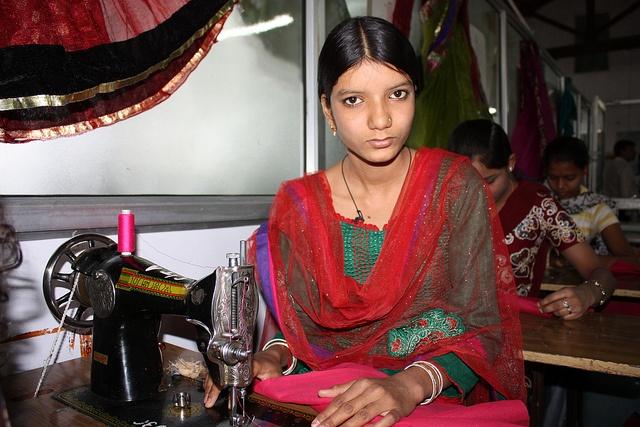

While those of us in the Western world tend to think of slavery as a thing of the past, that couldn't be further from the truth.
Nearly 46 million people worked in some form of modern slavery as of this year, according to estimates from the Global Slavery Index. The individuals who make up this shocking figure touch products in every sector, from food and personal care to fashion and home goods.
After understanding the scope of the problem, tackling it can seem daunting -- especially for everyday shoppers who learn they are unsuspectingly purchasing items connected to child and forced labor. But you'll find a bevy of solutions at your fingertips if you take the time to look.
Read on for simple ways you can help stamp out modern-day slavery, and take action today!
Use tech to shop smarter
aVOID: aVOID is a plugin for your browser that will automatically tell you if a product is linked to child labor when shopping online. It works for popular online shopping destinations like Amazon, Asos, Target and Google Shopping. Click here to download now.
GoodGuide: Focused on food, as well as cleaning and personal care products, the GoodGuide app includes a barcode scanner that allows you to instantly learn more about a product you're eying. With a few clicks, you'll receive a rating based on the item's health, social and environmental impacts. Download for free on Android and iOS. You can also use the organization's product guide on your desktop for online shopping.
End Slavery Now: End Slavery Now, an American advocacy group with the National Underground Railroad Freedom Center, publishes an annual shopping guide to help you make smarter purchases. The latest guide was updated on Oct. 22 of last year and includes ethical chocolate and home goods, as well as travel companies that operate ethically and sustainably. You can also browse a list of slavery-free and fair trade companies on the organization's website.
Not My Style: Last year Alisha Miranda, managing director of London-based consultancy I.G. Advisors, had a bright idea: an app that tells shoppers how much their favorite fashion brands disclose about their labor policies. She took to Kickstarter to make it a reality. And, after barely meeting her target of 23,000 British pounds, she got to work.
The result is Not My Style, a free app for iPhone and Android that will launch in beta before the end of this year. Miranda and her team have already rated more than 80 U.K. high street stores on their consumer-facing transparency, with more in the works. Sign up here to be notified when the beta launch hits the app store.
Track your impact
Slavery Footprint: Operated by Made in a Free World, Slavery Footprint does what it says -- helps consumers determine their impact on workers worldwide.
The organization began as a partnership between the U.S. State Department and musician, filmmaker and advocate Justin Dillon. After the release of his 2008 documentary, "Call + Response," the State Department approached Dillon to help develop a narrative that would help people understand their connection to modern-day slavery -- and Slavery Footprint was born.
By answering 11 simple questions, you can ascertain how your daily behaviors and purchases are connected to forced labor around the world. You'll also receive suggestions about how to lighten your impact. Take the quiz now.
Connect with companies about their forced labor policies
Made in a Free World: The abolition advocacy group Made in a Free World began with Slavery Footprint to help concerned citizens understand how slavery touches their lives. The group then went on to analyze hundreds of companies' supply chains to root out forced labor.
Then, in response to user demand, the organization took things a step further with tools that allow conscious consumers to communicate with brands about forced labor. Through Made in a Free World's FDRM tool, users can easily send letters to top companies -- think: Walmart, Starbucks and Mattel -- to ask them to get serious about forced labor. Some companies have already received upwards of 30,000 letters through FDRM. Send yours now.
Fashion Revolution: Fashion Revolution began as a day of action in 2014 to mark the anniversary of the horrific Rana Plaza Factory Collapse, in which more than 1,100 Bangladeshi garment workers lost their lives. Fashion Revolution Day continued last year with a shot in the arm from social media and a poignant hashtag: #WhoMadeMyClothes.
But you don't have to wait until April 14 to take action with Fashion Revolution. The group now invites concerned shoppers to ask companies about their supply chains all year round. Use the group's simple tool to send a letter to your favorite brand and ask them who made your clothing.
Use certifications to shop with confidence
Fair trade: Don't feel like staring at a screen every time you shop? Fair Trade Certification lets you browse with confidence -- without a computer or smartphone -- by ensuring products have minimal impact on the environment and the workers who made them.
While several organizations certify fair trade, all of them ban forced and child labor and require fair pay for workers. Look for seals from Fair Trade USA, Fairtrade America, Fairtrade International, the World Fair Trade Organization and more to ensure your products were made ethically.
Goodweave: In addition to food and fashion, home goods often come with a hefty slavery footprint. Take, for example, the handmade carpet industry -- which exploits nearly 250,000 children worldwide. With the rise of artisanal products and boho chic, handwoven rugs are seeing something of a revival. But most shoppers picture their purchases empowering crafters in developing countries, not enslaving children.
Supported by the C&A Foundation, GoodWeave is looking to transform the rug industry by certifying child-labor-free rugs and providing education and opportunities to rescued and at-risk children.
When buying that artisanal rug for your home, look for the Goodweave seal to make sure it actually helped the artisan who made it and isn't hiding child labor in its colorful threads.
Join TriplePundit, C&A Foundation, Remake and Freedom Fund on Dec. 5 at 9 a.m. PT/Noon ET /6 p.m. CET for a Twitter chat to discuss forced labor – an issue that still plagues supply chains around the world -- in greater depth.
Image credit: Flickr/ILO in Asia and the Pacific
Despite Trump’s Promise, Economics Will Hasten Coal’s Decline


Donald Trump racked up huge margins across coal country in this year’s presidential election with his promise to make coal central to America’s energy mix again. But even Senate Majority Leader Mitch McConnell has acknowledged that will not be the reality any time soon as the natural gas boom continues at coal’s expense. Numbers compiled by the federal government also suggest that coal is on a steady decline.
The most recent data released by the U.S. Energy Information Administration (EIA) suggests that natural gas will displace coal even more in the coming years. This year to date, 34.7 percent of the nation’s electricity was generated from natural gas; coal-fired power plants, in contrast, provided 29.6 percent of America’s electrical power needs. Gas and coal ran about even last year, with each providing approximately 33 percent of America’s power.
Several factors are at play here. More stringent air-quality regulations at the federal, state and local levels have nudged more power providers to switch from coal to cleaner burning gas. The fracking boom, for better or worse, helped make natural gas more plentiful and therefore more cost-effective to fuel power plants.
But the deregulation of the energy markets over the years has also been a contributing factor to coal’s demise. Look closely at the IEA’s data, and you'll notice that utility-owned power plants are fueled by coal more than gas. Many utilities, however, buy electricity from independent power producers (IPPs), and those companies generate more power from gas than coal by an over 2-to-1 margin.
According to a 2015 Black and Veatch report, IPPs have an upper hand in regions such as the western states and northeastern U.S., as well as in states with unregulated energy markets. These companies also invest in clean-energy projects, from solar farms in California to wind power installations in Texas.
In short: The 21st-century energy infrastructure is already falling into place, and coal is the odd fuel out.
As the Economist reported last week, the writing is clearly on the wall. Ninety-one American coal plants closed in 2015, and 41 more are expected to shut down this year. The scalability of natural gas has made it price-competitive with coal extraction; meanwhile, renewables are becoming almost as cheap as fossil fuels, despite the global slump in oil prices.
If coal were to become America’s fuel of choice once again, an incoming Trump administration would have to launch an absurd policy that goes against Republican orthodoxy: Subsidize coal in order to make it more competitive than other sources of energy.
Considering the investments energy companies have made in their natural gas and renewable power infrastructures, such a move would send the pinstripes-and-briefcase crowd running to Washington almost immediately in order to quash any such “reforms.”
Critics of the natural gas boom scoff that natural gas is not a “clean” nor “renewable” fuel, and technically they have a point. But compared to coal, it has far less of an environmental impact, and some say it could be that “bridge” fuel to the future as renewables scale and become far cheaper.
And that renewable future is underway now. Offshore wind, once seen as a foolhardy and expensive proposition, costs half what it did a few years ago. Solar power has fallen to a record low, even less than 3 cents per kilowatt-hour in some markets, adding another nail to coal’s coffin.
The coal industry will scream and kick as much as it can to stay relevant, and indeed it succeeded in helping to catapult its man into the White House. But the reality is that coal is following the same path as the buggy whip, slide rule, VCR and telephone keypad.
Jobs in the clean-energy sector surpassed those in the oil, gas and coal extraction industries for the first time last year, Bloomberg reported. And in fact, jobs in the solar power business grew at a rate 12 times that of overall job creation. The future is here, and the only way the energy sector will go back is if there is government intervention – by an administration that claims it is hostile to regulation.
Image credit: Duke Energy/Flickr
In the Age of Trump, Business Leaders Must Take Up Climate Fight


For those who care about the fate of our warming planet, the last month presented a barrage of bleak headlines.
In America, President-elect Donald Trump has declared his suspicion that global warming is nothing but a hoax perpetuated by the Chinese and pledged to dismantle the landmark Paris climate agreement.
Meanwhile, hundreds of puffins — those brightly-colored, absurdly charismatic seabirds — have been washing up dead in Alaska, and scientists think climate change might be to blame.
Despite all of this, a group of corporate executives, sustainability consultants and environmental activists has spent the last three days in — wait for it — Florida mapping out a surprisingly sunny narrative about our future.
The consensus? If Washington is hell-bent on dismantling progress, the private sector must become equally hell-bent on protecting it.
“Complaining about the election and the incoming administration doesn’t help anybody," event organizer Jason Youner told the Guardian on Thursday. "We’re not here to debate whether there is climate change. We’re here to try to save the world, because the government’s not going to.”
The event, appropriately dubbed Companies versus Climate Change, began Wednesday with a keynote by David Fenton, a prominent publicist and climate change activist, who called on the audience to take up the banner of sustainability before it is too late.
“We are not winning the war of public opinion,” Fenton told the crowd, noting that only 16 percent of Americans consider climate change an urgent issue and less than half believe humans are to blame.
"That is not enough to get action," Fenton said, "and we have no program — no marketing, communications or mobilization program -- to raise that number.”
It was in the hope of changing this that Fenton spoke. The climate change movement is massive and well-funded, he said, but the people responsible for directing these ample resources aren't typically skilled communicators.
"If you come from the law, the sciences, the humanities or a policy background, you tend to have an innate belief that, if you explain the facts quietly to people, a lightbulb will go off in their head and everything will change," Fenton explained. "People in business know that is not how the brain works."
This year's election was a case in point, he continued — a triumph of emotion over reason.
“Trump had ‘make America great again,’" he said, "... And on climate change, we have ‘blah, blah, blah, blah, blah’ — the Tower of Babel. We have no simple message.”
What would that message be? Fenton said he and a team of advertising professionals were in the early stages of figuring this out. They don't have a clear winner yet. However, this much is clear: Whatever the message, it will have to strike the right emotional tenor.
“We have to have a balance, it seems to me, between a message that's predominately hopeful, so that people can hear us, and that has enough fear and urgency in it," Fenton said. "My formula is two-thirds hope, one-third fear.”
Equally as important as the message is who will deliver it. In particular, Fenton said, we need to lift up voices on the political right who are speaking out about climate change — people like Jerry Taylor.
Taylor, a libertarian, was a vocal climate skeptic before mounting scientific evidence convinced him to change his stance. Now, he directs the Niskanen Center, a Washington think tank that advocates for market-based solutions to climate change, among other things.
"By making people like [Taylor] better known, we open up political space for other Republicans to feel it is safe to come forward," Fenton said.
It was in the hope of promoting just such a dialogue that Fenton's firm — working with the Partnership for Responsible Growth — took out a series of 12 ads promoting mainstream climate science in the Wall Street Journal earlier this year.
“In 25 years, no [Journal] editorial had ever admitted that humans were changing the climate," Fenton said. The ads, which were highly critical of the paper, attracted a lot of attention — including from the Journal's op-ed editor, who initially refused to run them. He was overruled by the chief revenue officer.
“As a consolation prize, they charged us $10,000 more for that ad," Fenton said.
He urged the audience to support a similar, large-scale effort.
“There is currently no regularly visible business group on climate science and solutions," he said. "The only thing that works in marketing is regular visibility. There are business groups. There's some terrific ones. But there are none focused, day-in and day-out, on showing the public and policymakers the truth of this issue.
“I pray that we get together and organize a scientific marketing and communications campaign to turn this situation around," he concluded, "for the sake of our children and the world. Because if we don't do that, if we leave the predominant messaging and communications efforts to the enemies of progress, we will stay where we are.”Image credit: Flickr/Gage Skidmore
Is It Time to Remove Names from Resumes to Stop Bias in Recruiting?
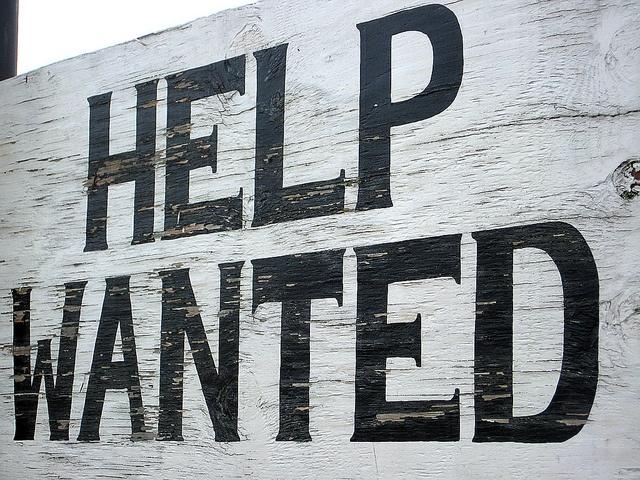

As the U.S. unemployment rate holds steady at 4.9 percent, we hear plenty of chatter about how companies are finding it hard to hire good help. Some companies even say they're forced to wage a “war for talent” in order to retain employees and attract top performers. But Mike Ettling, president of the human resources cloud company SAP SuccessFactors, says this ongoing struggle to hire on top talent is largely a myth.
In an interview with Forbes last month, Ettling says this dearth of talent is really the result of human resources recruiters not casting a wide enough net; and this stubborn problem can be largely attributed to unconscious bias in the workplace.
More organizations are trying to stop this problem, largely because it opens them to the risk of litigation over hiring discrimination. The results may be infuriating to the job candidate, but are a noble enough effort. Hence you may have a first interview by Skype or telephone, which may seem absurd when that company is located in your ZIP code. Or the questions may seem pallid and not even appropriate to the job in question: It is just that the hiring managers want to ensure that all of the job finalists have an equal shot and are treated fairly.
But the problems that hamper fair hiring practices are still all over the map. Job descriptions may be written in a way that tilts them in favor of the gender or personality type long linked to those roles. And much of the screening may be done by employees who will never work with that individual candidate once he or she is hired.
Some analysts suggest companies should go a step further and remove names from candidates’ resumes. The personal bias, after all, should be obvious: Recruiters and hiring managers, whether they are aware of it or not, may have a gut reaction against someone with names as diverse as Betty Sue, Mohammed, DeShawn or, in an extreme case, Keihanaikukauakahihulihe'ekahaunaele.
Silicon Valley, a region long accused of hosting companies that fall far short when it comes to diversity, is also home to a bank that's thinking about redacting names from resumes.
In an interview with Business Insider, one of Silicon Valley Bank’s human resources directors said the company began to consider such a move when it became clear that recruiters were quicker to question the credentials of female job candidates.
The bank claims employees have already undergone rigorous bias training. This included an exercise debating the merits of four different job candidates’ resumes – only to find out in the end they were from the same person, only with the names and genders entered differently.
The problem is hardly unique to the U.S. A 2014 study in France concluded that many companies tossed aside resumes that had “foreign sounding” names common in North Africa and the Middle East. A survey in the United Kingdom found that ethnic minorities struggled when applying to universities compared to the rate of acceptance for their white counterparts, despite having similar credentials.
The evidence suggests some companies are already launching name-free recruitment practices. Before the Brexit vote ended his tenure, U.K. Prime Minister David Cameron urged the country’s public and private sectors to hire on a “name blind” basis. A study completed in 2014 suggests that, while such anonymous job hiring practices cannot eliminate all forms of bias, this practice can be a step forward for fair recruiting and diversity in the workplace.
Image credit: Brenda Gottsabend